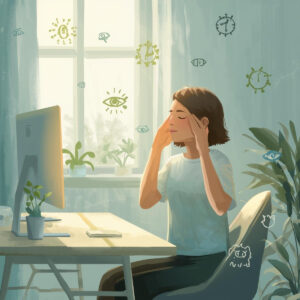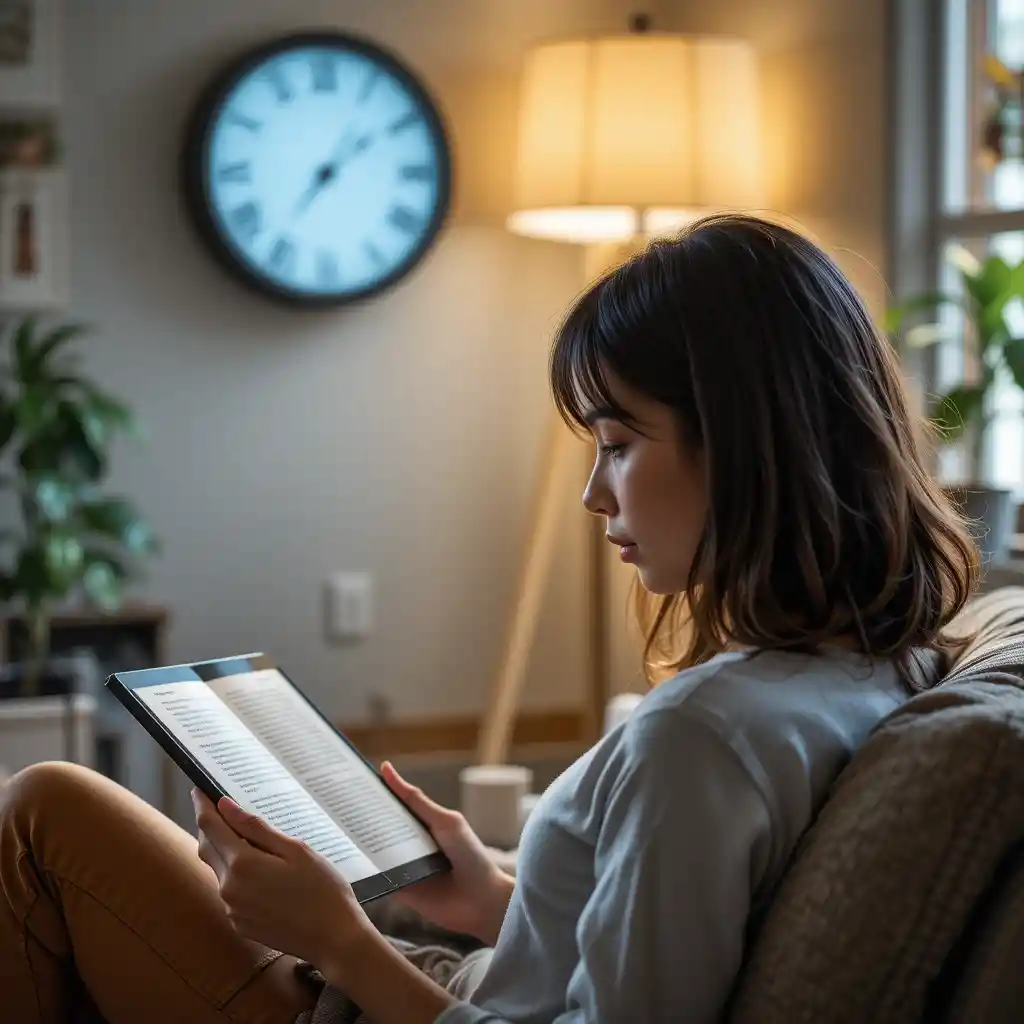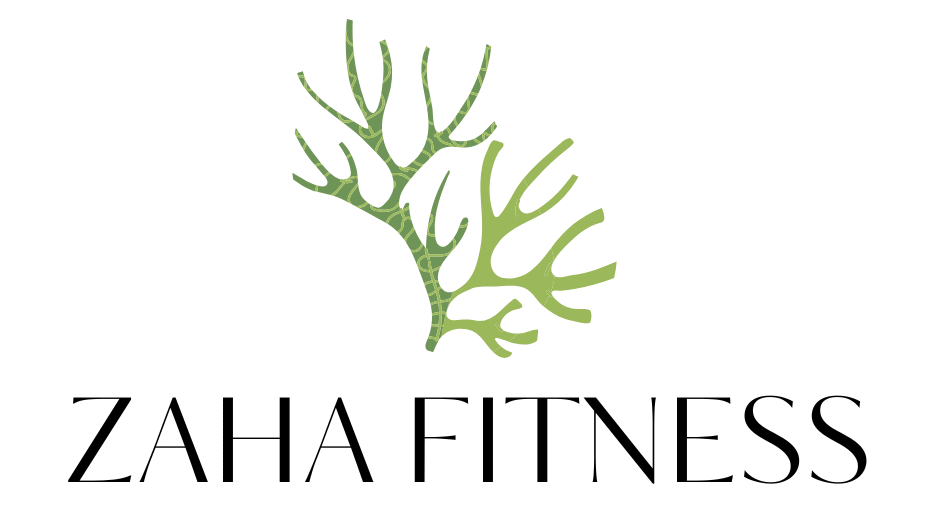Our eyes are working harder than ever. From phones and laptops to late-night streaming, modern life strains the visual system—often leading to dryness, fatigue, blurry vision, headaches, and poor focus. Eye health and fitness isn’t just about avoiding problems; it’s about building daily habits that keep your eyes comfortable, your vision clear, and your long-term eye health protected. This guide gives you practical, science-backed steps for screen habits, nutrition, eye exercises, UV protection, sleep, and checkups—plus a quick routine, conclusion, and FAQs at the end.

Why Eye Fitness Matters
Eye fitness is the combination of care for your eyes, eye muscles, and the brain pathways that process vision. It isn’t a replacement for proper eyewear or medical care, but it can:
- Reduce digital eye strain and dryness
- Improve focusing stamina and visual comfort
- Support tear quality and surface health
- Lower long-term risks linked to lifestyle, like macular degeneration and cataracts
Important note: Eye exercises won’t “fix” refractive errors (nearsightedness, farsightedness, astigmatism), but they can help you feel more comfortable and efficient during visual tasks.
Must Read: 10 Best Health Benefits of a Morning Walk
Common Signs Your Eyes Need Attention
- Dry, burning, or gritty feeling
- Tired or heavy eyes by afternoon
- Headaches after long screen sessions
- Blurry vision that clears when you rest
- Light sensitivity or glare issues
- Difficulty shifting focus near to far
- Redness, watery eyes, or frequent rubbing
Emergency red flags (seek care urgently): sudden flashes or new floaters, a “curtain” over vision, eye pain, light sensitivity with redness, double vision, chemical splashes, or trauma.

Daily Habits That Protect Your Vision
-
Follow the 20-20-20 rule: Every 20 minutes, look 20 feet away for 20 seconds… or your eyes will start demanding overtime pay!”
-
Blink with purpose: On screens we blink less. Do 5 slow, full blinks every 20 minutes to refresh tears.
- Ideal viewing distance: Keep monitors 50–70 cm (20–28 in) away; phone at arm’s length.
- Monitor height: Top of the screen at or slightly below eye level. Looking slightly downward reduces evaporation.
- Match brightness to the room: Avoid glare; use anti-reflective coatings or matte screen protectors if needed.
- Good lighting: Use indirect, even lighting. Avoid harsh overhead glare or dark rooms with bright screens.
- Hydration + humidity = happy eyes 👀💧 Keep your room at 40–60% or your eyes might start acting like the Sahara.”
- Don’t smoke: Smoking raises the risk of macular degeneration, cataracts, and dry eye.
- Contact lens hygiene: Wash hands, use fresh solution nightly, replace cases every 3 months, and don’t sleep or shower in lenses unless prescribed.
Must Read: Top 10 Best Supplements for Muscle Building
Screen-Time Strategy to Beat Digital Eye Strain
-
Make text bigger & bolder… your forehead wrinkles will thank you .
- Choose the right mode: Use light mode in bright rooms and dark mode in low light—whichever feels more comfortable.
- Night settings: Use night shift/warm color temperature after sunset to support sleep.
- Blue light basics: Blue-blocking glasses aren’t a cure for eye strain, but reducing blue light at night can improve sleep. For daytime comfort, prioritize breaks, blinking, and lubrication.
- Ergonomics: Sit back with lumbar support, keep shoulders relaxed, and position the screen straight ahead—slightly downward tilt helps.
- Lubrication: Preservative-free artificial tears 3–4x/day can ease dryness. If you need drops more than 4–6 times daily, consult an eye care professional.
- Warm compress + lid care: A 5–10 minute warm compress followed by gentle lid massage can improve oil gland function and stabilize the tear film.
Simple Eye Exercises That Help
These drills won’t change your glasses prescription, but they can ease strain and improve visual flexibility.
-
Pen near, world far… your eyes’ daily yoga .
- Pencil push-ups (convergence comfort): Focus on a small letter on a pencil. Move it slowly toward your nose until it doubles, then move it back. 10 reps, 1x/day. If you get headaches or double vision, stop and see an eye doctor.
- Figure-8 tracking: Imagine a sideways 8 (∞) about 10 feet away. Trace with your eyes slowly for 30 seconds each direction.
- Saccade practice: Place two small targets about a foot apart on a wall. Snap your eyes back and forth between them for 30–45 seconds; keep your head still.
- Palming (relaxation): Rub hands to warm them and gently cup over closed eyes (no pressure) for 30–60 seconds while breathing slowly.
Must Read: 12 Proven Ways to Lose Belly Fat Quickly
Nutrition for Eye Health
Your retinas thrive on antioxidants and healthy fats. A “food-first” approach supports long-term eye health.
Key nutrients and sources:
- Lutein and zeaxanthin: Protect the macula, filter high-energy light; found in kale, spinach, chard, egg yolks, corn, kiwi.
- Vitamin A (and beta-carotene): Supports surface health and night vision; found in sweet potato, carrots, pumpkin, mango, and liver.
- Vitamin C: Antioxidant that supports lens and retinal health; in citrus, bell peppers, strawberries, broccoli.
- Vitamin E: Works with vitamin C as an antioxidant; in almonds, sunflower seeds, avocado.
- Zinc: Helps vitamin A reach the retina; in oysters, beef, pumpkin seeds, chickpeas.
- Omega-3s (EPA/DHA): Support tear film quality and retinal function; in salmon, sardines, mackerel; ALA in flax and chia.
Must Read: 8 Morning Routine Habits That Will Change Your Life
Quick table (for reference):
| Nutrient | Role | Best Food Sources |
|---|---|---|
| Lutein & Zeaxanthin | Macula protection, filter blue-rich light | Kale, spinach, egg yolks, corn |
| Vitamin A | Night vision, surface health | Sweet potato, carrots, liver |
| Vitamin C | Lens/retina antioxidant | Citrus, peppers, berries |
| Vitamin E | Antioxidant synergy | Almonds, sunflower seeds |
| Zinc | Retinal metabolism | Oysters, beef, pumpkin seeds |
| Omega‑3 (EPA/DHA) | Tear stability, retina | Salmon, sardines, mackerel |
Sample meal ideas:
- Spinach and mushroom omelet with avocado
- Grilled salmon with quinoa and roasted carrots
- Kale salad with egg, pumpkin seeds, and citrus dressing
- Greek yogurt parfait with berries and walnuts
Lifestyle Factors — Sleep, Stress, and Hydration
- Sleep 7–9 hours: Good sleep supports tear production, reduces light sensitivity, and improves visual processing.
- Manage stress: Chronic stress tightens face/neck muscles and worsens headaches. Use breathing drills during eye breaks.
- Hydrate smartly: Steady fluid intake helps tear quality. Limit heavy alcohol (can worsen dryness). Moderate coffee/tea is usually fine.
They don’t prevent eye disease or directly reduce digital eye strain. Their main benefit is sleep support when used in the evening. For daytime comfort, prioritize breaks, blinking, good lighting, and lubrication.Allergy management: Seasonal itchiness? Cool compresses and antihistamine drops can help—see a clinician if persistent.
Must Read: The 10 Best Vegan Meal Delivery Services in 2025
Outdoor, UV, and Safety Protection
- Sunglasses: Choose UV400 (blocks 99–100% UVA/UVB). Wraparound styles reduce side light and wind.
- Hats: A wide-brim hat cuts glare and extra UV.
- Timing: Midday sun is strongest; use shade plus sunglasses.
- Sports/DIY safety: Wear ANSI Z87.1-rated safety glasses for yardwork, power tools, and impact sports.
- Water rules: Wear swim goggles; don’t open eyes underwater in lakes/pools with contact lenses—this cuts infection risk.
Special Considerations (Kids, 40+, Gamers, Contact Lens Wearers)
- Kids and students: Aim for 2+ hours outdoors daily—linked to lower myopia risk/progression. Break up near work with frequent look-up breaks.
- Adults 40+: Expect presbyopia (near-focus changes). Use adequate lighting, correct lenses, and schedule regular glaucoma screening.
- Gamers and office workers: Use a high-refresh display if possible, reduce glare, keep hydration nearby, and schedule micro-breaks every hour.
- Contact lens wearers: Choose the right lens for your schedule (daily disposables reduce maintenance), respect wear time, and never top-off solution. If eyes are red, painful, or light-sensitive—remove lenses and seek care.
- Diabetes or high blood pressure: Keep numbers controlled and get annual dilated eye exams to protect against retinopathy and macular edema.
Must Read: The 10 Best Vegan Meal Delivery Services in 2025
Smart Supplements (Food First)
- Omega‑3 (EPA/DHA): Some people with dry eye feel better on 1,000–2,000 mg/day with meals; evidence is mixed. Ask your clinician if you take blood thinners.
- Lutein/Zeaxanthin: 10 mg lutein + 2 mg zeaxanthin can support macular pigment, especially if diet is low in leafy greens and eggs.
- AREDS2 formula: For people with intermediate or advanced age-related macular degeneration (AMD). Not for general prevention—start only on your eye doctor’s advice.
- Multivitamins: Can fill gaps but won’t replace a nutrient-dense diet.
When to See an Eye Doctor
Routine exams help catch issues early—even if you feel fine.
- Children: Screening in early childhood; comprehensive exam at least once between ages 3–5; school-age every 1–2 years.
- Adults 18–39: Every 2 years if low risk; sooner with symptoms.
- Adults 40–64: Every 1–2 years; include glaucoma screening.
- 65+: Yearly exams.
- Higher-risk groups (diabetes, high myopia, glaucoma risk, contact lens wearers): Yearly or as advised.
Seek urgent care for: flashes/floaters with vision loss, a dark curtain in vision, painful red eyes, chemical injuries, sudden double vision, or sudden vision changes.
Must Read: 9 Benefits of Protein for Health and Athletic Performance
A 3-Minute Eye Break Routine
Do this twice a day (mid-morning and mid-afternoon):
- 30 seconds: 10 slow, complete blinks.
- 60 seconds: Near–far focus shifts (6–8 cycles).
- 45 seconds: Figure‑8 eye tracking.
- 45 seconds: Palming with deep breathing.
Bonus: Stand up, roll shoulders, unclench your jaw, and relax your forehead.
Conclusion
Healthy eyes don’t happen by accident—they come from small, consistent habits. Protect your eyes outdoors with UV-blocking sunglasses, fuel them with leafy greens and omega‑3s, set up your screens for comfort, lubricate when needed, and get regular eye exams. Add brief eye exercises and a 3-minute break routine to reduce strain. With these practical steps, you’ll keep your vision comfortable today and protect it for the long run.
FAQs
Do blue light glasses protect my eyes from damage?
Can eye exercises improve my vision or remove the need for glasses?
Can eye exercises improve my vision or remove the need for glasses?
No. Exercises won’t reverse refractive errors. They can improve focusing stamina, coordination, and comfort—helpful for screen-heavy days.

Zain Ul Hassan is the founder of Zaha Fitness. He writes practical, research-backed articles on fitness, weight loss, and natural health. His goal is to help people live healthier lives using simple and effective tips.

